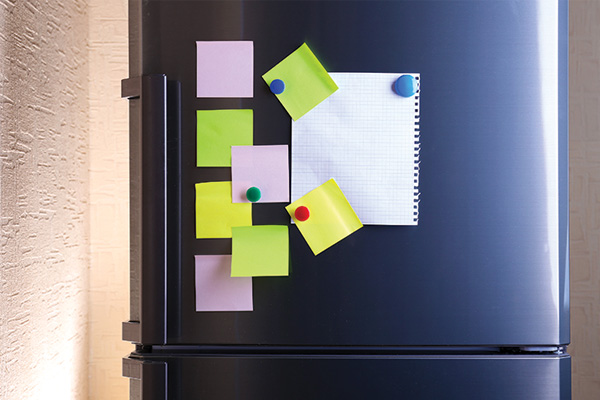You can tell a lot about how a family lives by their refrigerator – not what’s inside, but what’s hanging on the outside.
If your fridge door is strewn with business cards, kids’ drawings, calendars, photos, schedules and other bits of minutiae, chances are, you’re living with big-time clutter – not just in the kitchen, but everywhere in the house.
“The sheer volume of objects clinging to [your fridge] may indicate how much clutter can be found throughout your home,” reads a press release from UCLA about a study on the subject.
In 2012, researchers affiliated with UCLA’s Center on Everyday Lives of Families, or CELF, studied American families’ material possessions and lives. The results were compiled into a book called Life at Home in the Twenty-First Century.
The exhaustive study – “an incredibly labor-intensive enterprise,” said lead author Jeanne Arnold – looked into the daily lives of 32 dual-income, middle-class families in the Los Angeles area. The team made some interesting discoveries, including some situations that future homebuyers and remodelers should try to avoid.
For example, garages were so packed with household overflow that cars were parked in the driveway or on the street. No wonder a recent poll by the National Association of Home Builders found that both first-time and move-up buyers rated garage storage among their top five most essential features.
Garages do provide storage, of course, but often not for automobiles. Only one in four of the garages in the CELF study could be used for cars because they were so packed with other stuff. This, even though keeping a car out of the weather is one of the best ways to extend its life.
The book labels garages “the new junk drawer.” Many families said they were parking their stuff in their garages until they could decide what to do with it, but plans to sell items online or at a garage sale rarely materialized.
For the study, CELF sent archaeologists, anthropologists and other social scientists to systematically study families’ home lives. The resulting book presents what co-author Elinor Ochs, an anthropologist and CELF’s director, says is a troubling picture of costly space that often goes unused.
Here’s a brief look at some of the other findings.
- One of the most common renovations the 32 homeowners undertook was upgrading their master bedrooms, usually with the addition of an adjoining bathroom. Often designed and decorated to evoke luxury hotels, these private spaces were envisioned as refuges from the hustle and bustle of family life.
Yet researchers found that other than for sleeping and bathing, these spaces were rarely used, even though the cost to upgrade them often ran above $80,000 – an amount that approached or exceeded the homeowners’ combined annual salaries. Families gladly spent that money, while ignoring “vexing pinch-points” such as crowded kitchens.
- Even in the L.A. region, with its favorable year-round weather, families hardly used their yards. Nearly three out of four sets of parents spent no leisure time out back, and about half their kids didn’t, either. “They could not manage to carve out time to relax, play, eat, read or swim, despite the presence of such pricey features as built-in pools, spas, dining sets and lounges,” the researchers found.
In other words, those major expenses turned out to be mostly for looks.
Arnold said that families are “very sedentary at home. The ideal of indoor-outdoor living – the California dream since the 1950s – seems increasingly out of reach.”
- The volume of these families’ possessions was sometimes overwhelming: One family actually stored their dirty clothes in an unused shower. And these messes affected moms and dads very differently.
“Mothers who lamented messy or cluttered rooms or unfinished remodeling projects when describing their homes were more likely to have elevated levels of stress hormones,” read a news release, while fathers often mentioned no messes at all.
“They were unaffected physiologically,” said Arnold. “The differences between parents and their comfort level about clutter and its long-term impact on well-being are pretty astonishing.”
- Just 3 percent of the world’s children live in the United States, but their families buy more than 40 percent of the toys purchased globally. Most homes in the study had at least 100 toys on display, and several had more than 250. And countless other toys were stashed in closets or under beds.
- Shopping at big-box stores leads to stockpiling, which compounds clutter. Nearly half the families had a second refrigerator or freezer to accommodate extra food, and a few even had a third.
“I don’t think Americans intend to collect so much,” says co-author Anthony Graesch, an assistant professor of anthropology at Connecticut College. “But we’re really bad at ridding our homes of old possessions before buying new stuff.”
Lew Sichelman has been covering real estate for more than 50 years. He is a regular contributor to numerous shelter magazines and housing and housing-finance industry publications. Readers can contact him at lsichelman@aol.com.

